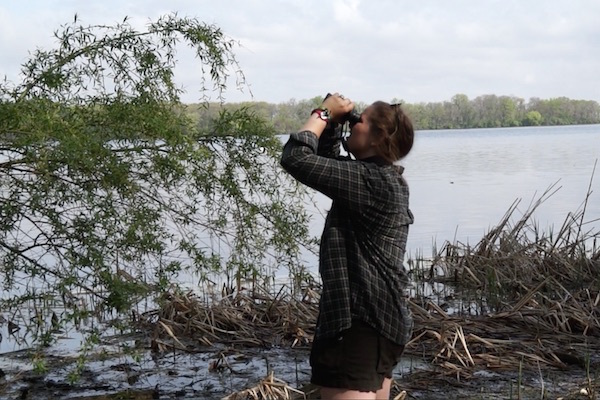Students provide feedback and lessons learned for campus master plan

Hannah DePorter, a freshman majoring in wildlife conservation, made her observations along Willow Creek, in the Lakeshore Nature Preserve and near her residence hall.
Photos: David Tenenbaum
The University of Wisconsin–Madison is a campus full of memorable spaces, from Library Mall to the Memorial Union Terrace, from Picnic Point to the lush green rise of Bascom Hill.
Each evokes a sense of place — an intimate and profound connection— that draws us to them and gives them meaning.
This notion is driving the next UW–Madison campus master plan, which focuses on making campus more livable, workable, and sustainable over the next 20 years. It also drove Trish O’Kane to take a nontraditional approach to her environmental studies class this semester. Her students immersed themselves in lessons in “place” and, last week, offered input to campus master planners, including representatives from the lead planning and design firm, SmithGroupJJR and landscape architecture firm, Hoerr Schaudt.
“I want their work to be real. I want my students to contribute and realize they can make a difference, both on campus and for the natural world,” says O’Kane, a graduate lecturer in the Nelson Institute for Environmental Studies. “So much of their education so far has taken place indoors.”
Trish O’Kane with some of the trash DePorter collected along Willow Creek.
That changed this semester, when she directed students to choose a location on campus and spend 30 minutes a day there, five days a week, keeping a journal of their observations, including sights, sounds and smells.
This meant frigid, snowy days in January and February, and cool, wet days in March and April. The project counted for 50 percent of their grade, so students couldn’t let the elements keep them from making their journal entries.
For students like Hannah DePorter, a freshman majoring in wildlife conservation, it was an opportunity to experience the unexpected. DePorter chose to make her observations along Willow Creek, in the Lakeshore Nature Preserve and near her residence hall.
O’Kane calls DePorter the “next John Muir” because once DePorter discovered an owl living in her territory — and within a few short but blustery weeks, one owl became three — everything changed. She began spending hours every day observing there, says O’Kane, taking notes from her hammock at all hours of the day and night.
For Matt Van Ommeren, a freshman likely to major in mathematics or economics, the course gave him a brand new perspective. He chose to observe at Smith and Ogg residence halls.
“Just through observing my territory, I saw these plants that had berries and I saw starlings with berries in their mouths. It made me wonder, where are (the berries) coming from?” he says. “It made me think: Let’s choose plants that are good for the wildlife because diversity of wildlife is really what’s interesting in the area.”
This is not something campus planners have concentrated on in the past, says Gary Brown, UW–Madison director of campus planning and landscape architecture in Facilities Planning and Management.
Student Carly Malavé presenting her thoughts to the class.
“We need to do more work on species selection, shrub planting, drawing wildlife into the campus by providing great food sources,” Brown said following the class presentations on April 30. “We need to be more specific about what we’re planting.”
The 10 other students in O’Kane’s class shared their input with their peers and with campus planners in four-minute presentations, considered part of their final exam, which includes a 650-word report.
They provided suggestions such as adding more seating along Bascom Hill, addressing accessibility and transportation issues on campus, and installing more waste receptacles to help keep campus natural areas clean. DePorter collected a large amount of trash in a single session at Willow Creek, which she brought along for her presentation.
The planners had the opportunity to ask the students questions and follow up with their suggestions. One student, Rachel Baruck — a sophomore majoring in political science — even provided hand-drawn blueprints to accompany her suggestions for the green space near Van Vleck Hall.
“Clearly, we need to add more seating areas on campus,” Brown said following the presentations. “We’ve heard that loud and clear.”
The planners had the opportunity to ask the students questions and follow up with their suggestions.
Throughout the course, O’Kane brought in guest speakers, from UW–Madison forest and wildlife ecologist Professor David Drake, who is studying the campus foxes and coyotes, to an ecologist from UW-Platteville (and a UW–Madison grad) who taught the students about the impact of sound on natural spaces.
It was Yi-Fu Tuan, emeritus professor of geography at UW–Madison, who said: “Place is security and space is freedom. We are attached to one and longing for the other.” O’Kane hopes that her students, who range from freshmen to graduating seniors, pay attention to these longings. She wants them to take lifelong lessons from this course experience and feel a connection to their campus, both now and as it changes into the future. The campus master plan should be finalized by 2016.
To hear Van Ommeren reflect on his experience in the class, it seems O’Kane may receive her wish.
“I wouldn’t consider myself a nature person, necessarily, and at first it was hard for me to go out and just spend 30 minutes, especially in the cold, looking for wildlife,” he says. “But I would say I definitely gained an appreciation for nature and I have a better understanding of urban wildlife. It’s something I will keep noticing and appreciating — like, since the course began, I’ve been noticing bird calls and I think: ‘Where are they coming from and what kind of tree are they visiting?’”




